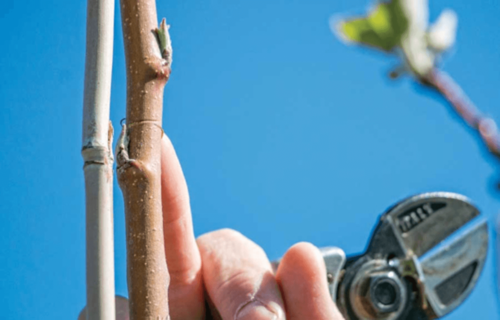Reducing The Blind Wood
Musacchi recommends notching and girdling just as deep as the bark and phloem to reduce blind wood. He says bending tends to result in two to three more nodes of blind wood than clicking-type pruning methods.
Researchers have examined a number of ways to minimize the other effects of apical dominance in WA 38, including girdling and notching the central leader and different pruning techniques — a “click” system vs. bending limbs and fastening to the trellis wire.
Musacchi is adopting a click pruning technique. This method involves tipping the end of the branches on one-year wood to minimize the blind wood.
Tipping once at 1 year old, then returning the following year to tip again, leaving two to three vegetative buds, will help to increase bud swelling at the base of the branch and reduce the blind wood.
Bending tends to result in two to three more nodes of blind wood than clicking-type pruning methods, Musacchi said.
Girdling is ideal for WA 38 trees on a bi-axis training system, because growers don’t want to lose 2 feet of crop to blind wood, especially in a fruiting wall, Musacchi said.
He recommends a very light girdle around just the bark and the phloem, “every foot, sometimes even more often — every 5 to 6 inches — if necessary.”
“Honestly, the girdling did extremely, extremely well,” he said. “There is no blind wood through all the length of the fruiting wall.”
Musacchi did not girdle a spindle block planted as finished trees, which had significant feathers — 20 to 30 feathers per tree for trees on Geneva 41 rootstocks, and 10 to 15 feathers per tree for those on Malling 9 Nic 29 rootstocks. This means that girdling can be adopted only if necessary.
Generally, the click system is resulting in better bud breaks the following year, but it’s more effective in vigorous conditions, Musacchi said.
However, in a V system, because the trees are planted closer together and are less vigorous, the effects were not as evident, because the length of the branches is shorter.
In addition, a mechanical pruning trial at the Prosser, Washington, site is showing promise. Mechanical pruning cuts off the tips of branches, thus removing their inherent apical dominance, and helps to stimulate bud break closer to the trunk, or axe, of the tree and minimize blind wood, Musacchi said.
Researchers mechanically pruned for the first time last year, then did so again in February.
The result: Every cut is resulting in one, two or three buds close to the axe, minimizing the blind wood and ensuring short limbs that improve fruits’ exposure to sunlight.
Mechanically pruning also prepares a fruiting wall for mechanical harvest in a couple of different ways, Auvil said.
Eliminating longer fruiting limbs from rows reduces the potential for damage by limbs that could be sucked into a vacuum harvester, damaging fruit that enter the machine when a limb is in the wrong place.
“The other really, really big advantage for the robotics format, particularly for the bi-ax system, in looking at mechanical pruning, is the uniformity of color and maturity,” he said.
Pollinizer Reminder
Researchers are also reminding growers who intend to plant WA 38 to remember to order their pollinizers.
Growers should strive to get two different pollen sources distributed in each block — every 30 feet for every row — such as a Mount Everest and a Snowdrift, or midseason commercial apple varieties, such as Red Delicious, Golden Delicious, Granny Smith or Cameo, Auvil said.
Article by Shannon Dininny, Good Fruit Grower








